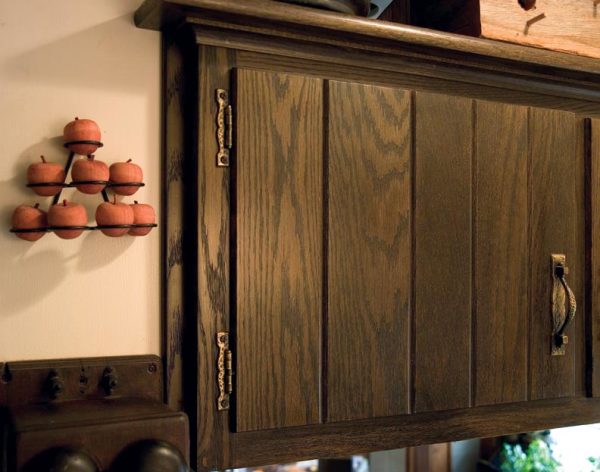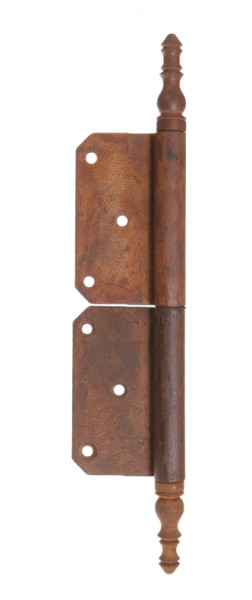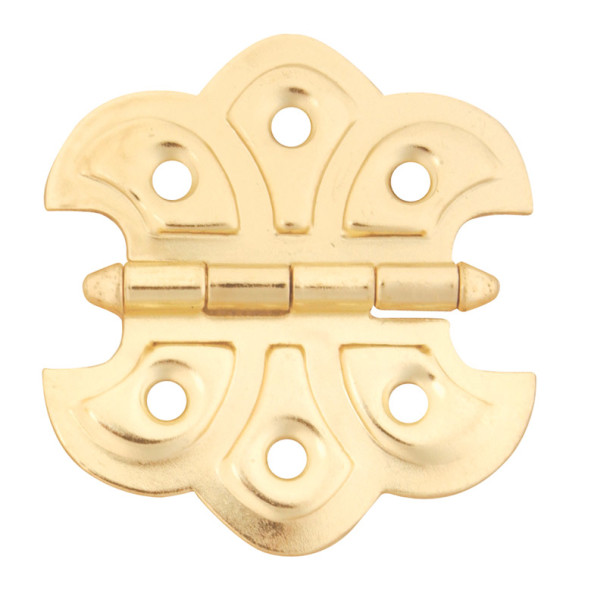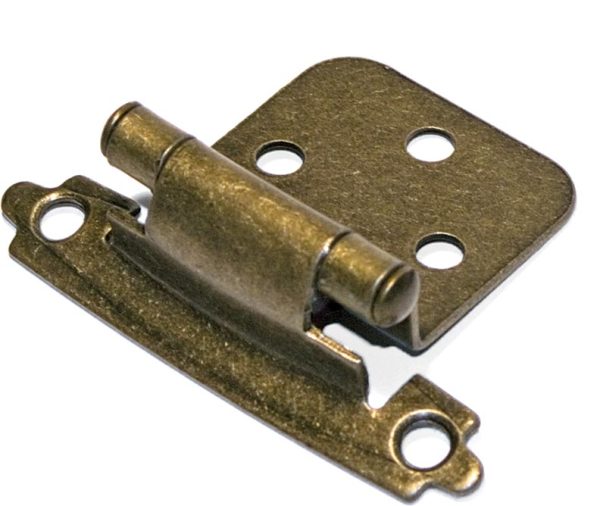Decorative hinges—like the hammered brass examples here—were popular on cabinet doors for decades. (Photo: Andy Olenick)
Period-appropriate cabinets require traditional hinges—this we know. But deciding which types of hinges best suit your old-house kitchen cabinets can be confusing. Moreover, should you ever consider updating your hinges to increase functionality—well, that can be frustrating. How, then, can you wade through today’s vast sea of hinge offerings? To start, it helps to think of hinges as being on an evolutionary curve. The earliest were quite simple, functional, and meant to be seen. As time went on, and the styles of cabinet doors changed, hinges became less and less visible, with the most modern offerings in the lot being completely hidden.
Inset Doors
Butt hinges, like this non-mortised example, gave cainbets a cleaner look, but still offered subtle decoration on knuckles ending in ball or finial tips. (Photo: Van Dyke’s Restorers)
The earliest standardized cabinets were face-frame construction, meaning that the wood edging the front of the cabinet resembles a picture frame, and can be clearly seen. These cabinets, in use from the 19th century into the 20th century, featured inset doors that sit flush inside the frame’s opening. The earliest inset doors were attached to the cabinet with simple surface hinges—low-tech hinges that are mounted to the front of both cabinet and door.
Surface hinges began as purely functional, in basic shapes like T-straps, L’s and H’s that were designed to hold up well and operate smoothly (although often a little loose in the knuckle), and they could be made out of brass or hammered iron. Surface hinges eventually developed more ornamental designs, like the butterfly hinge, featuring two leaves roughly shaped like a butterfly, sometimes sporting cutout designs.
Another basic hinge type used with face-frame cabinets is the butt hinge, where leaves attach to the edge of both cabinet and door, so that the knuckles show but the leaves are hidden. Some of the most popular of these were ball-tipped. Butt hinges afforded cabinets a cleaner look, and they were also quite durable and flexible, allowing for cabinet doors to be taken down when necessary by simply removing the pin. Butt hinges were almost always mortised. As for metals, in 1909 the guide Builder’s Hardware noted that, “Steel butts of this type can be procured in all finishes, but for high-grade work, bronze metal is always employed.”
Lipped Doors
Beginning around 1900 or so, cabinets with lipped doors came into fashion. These doors have a rabbet cut all the way around their back edge, which allows them to close into the opening and sit over the frame at the same time. Cabinets with lipped doors could be readily ordered in an array of sizes from millwork catalogs at the turn of the century. These doors require an offset hinge, one that jogs around the edge of the lip in order for the door to lay flat. Offset hinges can be either surface-mounted or ‘half and half’—that is, mortised into the door’s backside and surface-mounted on the cabinet’s frame.
Butterfly surface hinges (top) were meant to be seen, and could have elaborate lines and cutout patterns. Half decorative, half hidden, hinges like the one on bottom were meant to be mortised on the plain, interior-mounting side. (Photos: Courtesy of Van Dyke’s Restorers/Rejuvenation)
Decorative styles exist here as well, with the most common being either a simple, elongated brass oval for the surface mount, or one of a rustic hammered black rectangle with trefoil tips on the top and bottom. Hoosier cabinets, those early 20th century must-have items for every well-outfitted kitchen, had their own style of decorative offset surface hinge (one where both sides of the hinge are usually surface-mounted), depending upon the company that made them. Many of these are also available for purchase today, and they can sometimes be a good fit for retro kitchens as well.
Offsets quickly developed to have self-closing mechanisms via a spring in the knuckle that allowed homeowners to close the doors with less effort. These hinges, originally known as ‘single-acting hinges,’ were being used on other household applications (like lavatory doors) by 1910, and migrated to use on kitchen cabinets within a decade or so. Another point to note on inset hinges is that standard sizes have varied through the years. Pre-1950, a range of inset sizes were used, from 1⁄2″, to 5⁄8″, to ¾”, while today’s standard inset hinges measure 3⁄8″, which is something to consider when replacements are needed. It’s still possible to find inset hinges in non-standard sizes, but they usually come in a limited range of finishes.
Overlay Doors
Starting in the last century, overlay doors that are larger than the cabinet opening—fully covering the frame—came into popular use. After the mid-1950s, these doors appeared on frameless cabinets—built without rails and stiles, which are also known as European-style cabinets.
Self-closing hinges, like this offset example, contain a hidden spring inside the knuckle. (Photo: Nathan Winter)
This type of cabinet always uses interior-mounted hinges that are completely hidden when the cabinet’s doors are closed. Also known as a concealed cup hinge or a 35mm hinge (for the European system that developed it), these hinges consist of three parts: a base plate, an arm, and a cup. The cup is fitted into a mortise cut on the inside of the door, while the arm slides over a base plate screwed into the cabinet’s interior.
When used on an overlay door, concealed hinges swing the door entirely out of the way of the opening, so that interior pull-out drawers can be mounted flush with the insides of the cabinet, and still pull easily and completely out. Another benefit is that these hinges can be adjusted to hang higher or lower with a simple twist of the screws, without having to remove the door.
Virtually all cabinet hinge styles, including the earliest, are now available with a self-closing feature. And concealed cup hinges can be purchased to fit any style of cabinet door, including inset doors, as long as the right base plate is selected and the door can accommodate the depth needed to fit the cup.







